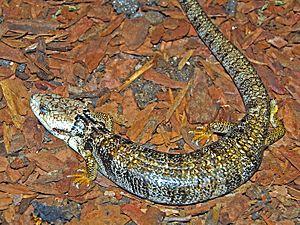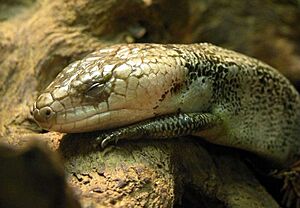Pink-tongued skink facts for kids
Quick facts for kids Pink-tongued skink |
|
|---|---|
 |
|
| Conservation status | |
| Scientific classification | |
| Genus: |
Cyclodomorphus
|
| Species: |
gerrardii
|
| Synonyms | |
|
|
The pink-tongued skink (Cyclodomorphus gerrardii) is a type of lizard. It belongs to the skink family called Scincidae. This skink is found only in Australia. People also often call it the pink-tongued lizard.
Its name comes from its special feature: a pink tongue! This is different from the blue tongues of its relatives, the blue-tongued lizards.
Contents
Naming the Pink-Tongued Skink
The scientific name gerrardii honors a British herpetologist named Edward Gerrard. He lived from 1810 to 1910. Edward Gerrard was a key helper for John Edward Gray at the British Museum.
Where Pink-Tongued Skinks Live
The pink-tongued skink lives only in Australia. You can find it along the eastern coast. Its range stretches from Springwood, New South Wales, up to the Cairns Region in Queensland.
What Pink-Tongued Skinks Look Like
The pink-tongued skink is a fairly large lizard. It can grow up to 45 centimeters (about 18 inches) long. This measurement includes its tail.
It has a thin body and a long, slender tail. The tail can even grip things, like a monkey's tail. Its legs are strong, with long toes and sharp claws. The skink has a clear neck and a rather large head. Males usually have wider heads than females.
Adult skinks have a pink tongue. Their back is usually slate-grey or fawn. They have dark grey, brown, or black bands across their body. These bands are clearer on males. There are about 20 bands from the neck to the tail.
The belly of the skink is white, pinkish, or creamy brown. Sometimes it has marbled patterns. Their scales are smooth. On the head, the scales have darker edges. Adult skinks have a dark snout tip and some dark spots on their head. Their legs are spotted or streaked with dark colors.
Young pink-tongued skinks look a bit different. They have very clear black bands on a light grey body. Their head has several dark spots, especially under the eyes. The tip of their snout is light. And here's a cool fact: their tongue and mouth are blue when they are young! This changes to pink after about three months.
Pink-tongued skinks are often confused with eastern blue-tongued skinks. But the pink-tongued skink has a pink tongue when it's an adult. It's also much thinner than the blue-tongued skink. It has a longer, narrower tail and a smaller head. Its legs are also longer and more developed.
How Pink-Tongued Skinks Live and Behave
Pink-tongued skinks live in wet forests and rainforests. They also like moist areas in woodlands. They hide under leaves, in hollow logs, or in cracks in rocks and trees. Their slim body helps them move easily through thick plants.
When moving on smooth ground, they wiggle their body from side to side. But when they go through grass or climb branches, they hold their back legs close. They move their tail in a side-winding way, using only their front legs to climb.
Their main food is snails and slugs. They hunt for food during twilight hours and at night in summer. In cooler months, they might also hunt during the day. To crush snail shells, they use their large, flat teeth at the back of their jaw.
Pink-tongued skinks are good climbers. They use their tail to help them grip branches. While they don't live in trees all the time, they will climb to find food if needed. Young skinks seem to climb more often. This helps them avoid being eaten by predators.
When a pink-tongued skink feels threatened, it raises its body off the ground. This makes it look bigger. It also flicks or vibrates its tongue very fast, much like a snake does.
Pink-Tongued Skink Reproduction and Life Cycle
Courtship for pink-tongued skinks happens in early spring. This period lasts about six weeks. During this time, male skinks have been seen fighting each other.
When they mate, the male holds the female's head with his jaws. Then he climbs onto her back. After about 101 to 110 days, the female gives birth. This happens in early summer.
Female skinks have large litters, usually 20 to 30 babies. The largest recorded litter had 67 babies! The babies are born live. During birth, the female holds her back legs close to her body, similar to how she moves through grass. She gives birth to one baby about every 30 minutes.
The young skinks are born curled up in a thin membrane. They eat this membrane after they break free. Right after birth, the young skinks start flicking their tongues. Their tongue and mouth are dark blue, and their belly is black. After about three months, their tongue turns pink and their belly becomes mauve.
The young skinks are independent right after birth. They don't need any parental care. They start eating slugs and snails on their own. They become ready to have their own babies at about 22 months old.



